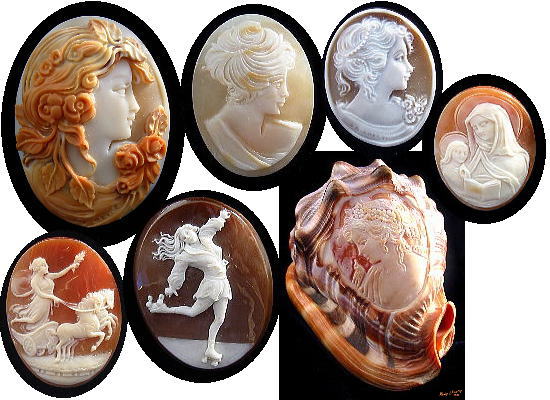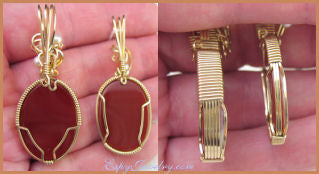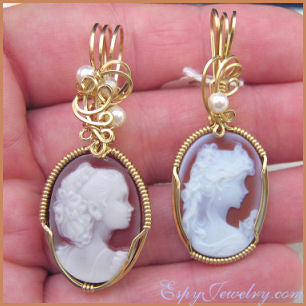Cameos

Cameos, in the most generic sense of the word, can be made of so many different things - hand carved shell, hand carved agate, ultrasonically carved agate, poured "agate", coral, mother of pearl, turquoise, molded resin, glass, painted porcelain, etc. The most popular cameos however are shell cameos and blue/black agate cameos.
Cameos can be carved in relief or intaglio. In relief is the most popular and means that the surrounding material is cut away from the image being carved, allowing the image to project above the surface. Intaglio means that the image is carved into the stone, so that it is below the surface level. When intaglio is done on a stone, the smooth surface of the top of the stone is carved. When intaglio is done on a piece of glass, the bottom surface of the glass is "carved" and usually painted, leaving the top of the glass smooth.
Shell Cameos
Ultrasonically Carved Agate Cameos
Laser Carved/Etched/Engraved Agate
Poured "Agate" Cameos
Polymer Clay Cameos
Resin Cameos
Shell Cameos
Hand-carved cameos are wonderful works of art - small sculptures that just entrance you with their beauty and detail.
Unlike agate, shell does not lend itself to machine techniques. and so shell cameos are still hand carved, using mostly traditional techniques. Many different types of shells are used, but the most prevalent are the carnelian shell (bullmouth helmet cassis rufa - peachy & white) and the sardonyx shell (emperor helmet - brown & white - more expensive). Pink cameos may come from pink conch (roselyn shell - white head on a pink background) or more rare, may be angel skin coral (overall pink/white/salmon color). While there are artists carving shell cameos around the world, the most famous place is Torre Del Greco, Italy, a little village at the foot of Mt. Vesuvius.
Good quality, most often done by apprentice carvers, have crisp details. The images on these cameos are done over, and over, and over. These cameos may be done in an assembly line fashion, with one carver doing the same section of the image on each of the cameos. While there will be variances between each one, since they are hand carved, they do not have the uniqueness of the higher grades. On the lower end of good quality, cameos may be slightly different in color from one side of the shell to the other, may be slightly off center, or may have a "lump" (uneven curvature) in the shell that was not used to its best advantage.
Better and best quality are more sculptural - the edges may be rounded or undercut, so they stand away from the shell. The images may be repeated, or you may see the same face from different angles, but not in the quantity of the good grades. These cameos are carved from start to finish by one artist and may take a week or more to complete. Master carvers are graduates from the art institute in Torre Del Greco. Their works are more artistic, often originals, and often signed.
Americans tend to grade cameos on an A/B scale. Europeans tend to grade cameos as commercial, extra quality, or art grade. Grading is very subjective and the grade vs quality can be meaningless. For example, one person grading a cameo may give it a higher grade because it has flowers, pearls, or other adornments. Another grader may only increase the grade if those adornments are done well.
In general, an A or extra quality grade is highly detailed, proportionate, and uses the natural colors of the shell well. Well-detailed eyes, nose and other facial features are imperative. A B or commercial grade is still very nice, but when laid next to the A grade, you can see the differences - especially in the eyes, nose, and other proportions. Art grade cameos focus on artistic expression. They are done in limited quantities and command very high prices.
I buy cameos that I like. I will choose an "unadorned", well carved piece that I don’t see everywhere over an "adorned" piece where the adornments are not carved as well or where I know the subject has been done over and over and over. The most important thing in selecting a cameo is do you like it? Cameos are art - we each have our own taste in art. Don’t be surprised however, if after buying a better quality cameos, you become hooked on the art and have to own more!
I have added some pictures of cameos at the top of this page. The carved shell is a display piece and is not actually how a cameo for jewelry would be produced. When producing jewelry cameos, a cutter prepares the shell for the carvers. The cutter divides the shell into the cup, which is the thicker, more richly colored part, and the rest, which is used for trinkets and souvenir items. The cutter then marks the cup, lining out all of the ovals, squares, or whatever other shapes he wants and fitting them close together to get the most possible blanks from the shell. They are then cut and the backs are smoothed and attached to a wooden stick for easy handling by the carver. The rough, curved outer layer is left exposed for carving. The thicker the layer of white on the outer layer, the more sculptural the carving can become.
The carvers sketch their subject onto the shell. They use both traditional carving tools such as the bullino and more modern tools such as small dental drills to remove the outer material of the shell, leaving the sculpted image.
Ultrasonically Carved Agate Cameos
The most well known place for agate cameos is Ider Oberstein, Germany. Some are still carved by hand, but the majority are now being carved ultrasonically. The machine carved cameos are then finished by hand, giving them a polished and sometimes a more sculpted look.
Ultrasonically carved cameos still have to start with a skilled artist creating an original, hand-carved agate cameo. The finished cameo then serves as a model for steel dies that are created using laser carving. The steel dies are then used to produce copper cutting tips, and the original cameo can now be reproduced ultrasonically.
Ultrasonic carving is done in liquid, using a template and vibrations to create the image. (This is different than laser carving, which uses a beam of light.) Ultrasonically carved cameos produce great detail, truly capturing the artist’s original work. Being machine produced, the image is likely to be used many times, but the quality from piece to piece remains the same.
Most agate material for cameos comes from Brazil. Very little of what is mined is suitable for the cameo trade. The natural agate used for cameos is layered in shades of gray color, ranging from a milky white to a dark gray. A layer of black agate with a white upper layer is called onyx. A layer of brown with a white upper layer is called sard-onyx. A layer of red with a white upper layer is called cornelian-onyx.
The cameo rough material is cut from agate with even parallel layers, slicing it so that there is a lighter layer above a darker one. The darker layer is softer and accepts dye, while the lighter upper layer is harder and does not accept the dye, remaining white or milky in appearance. (I have also read accounts that say the dye is chemically drawn out of the upper layer, to create the white layer.) The upper layer is then carved, exposing the darker layer underneath.
Grading is somewhat subjective and may vary with the supplier. The grade for agate cameos encompasses not only the carving, but also the color dye. Agate may be blue, dark blue/black, green, and red/purple. Most people agree that grade A agate cameos must have both flawless carving and flawless color. Grade A cameos can be quite expensive and is the grade of cameo used for most genuine agate cameo jewelry. Cameos made of more than two layers/colors are also available and very expensive.
Laser Carved ~ Laser Etched ~ Laser Engraved Agate
I do not believe any agate cameos are actually laser carved.
It is not uncommon to see agate slices however that are laser etched or laser engraved. This process will put your photo image into a pretty slice of agate. If the slice is small enough, it can be made into jewelry.
Poured "Agate" Cameos
In addition to carved cameos, there are molded/poured "agate" cameos. Poured agate cameos come primarily from Asia. They are made from agate powder (95%) that is mixed with a little bonding agent (5%) and poured into a mold. First the white layer is poured. Then, after a curing period, the colored layer is added.
Because they start with an agate powder, suppliers seem to think it is ok to call them an agate cameo. I can’t say that I agree with this, and so I call them poured agate. Just like a lab-created gem vs a genuine gem, they do look very nice and can be hard to tell from genuine agate cameos. They are usually less expensive than carved cameos, however, since many people do not realize there are poured agate cameos available, they may mistake them for genuine carved agate.
The poured agate cameos I have seen are detailed. When I put an ultrasonically carved agate cameo and a poured agate cameo in someone’s hand and ask them to tell me which is "real" and which is "imitation", they normally pick the poured agate cameo as being the "real" one, because of the detail. The image tends to stand up away from the background and have areas that give off a polished sheen. However, people normally prefer the color of the ultrasonically carved agate.
In general, I would say that I find the subjects on the ultrasonically carved agate cameos much more attractive and appealing than the poured-agate cameos. The primary reason I don’t buy the poured-agate cameos is that I just don’t see very many that I like.
Comparing ultrasonically carved cameos and poured cameos -
|
Back - both have a shiny back that is cool to the touch when you first pick it up, but then warms up quickly. On the "real" ones, the layer is very thin. On the poured ones, the layer is very thick. |
 Poured "Agate" is on the left, Ultrasonically Carved Agate is on the right. |
|
Side - the "real" ones are approximately 2mm thick. The poured ones are approximately 5mm thick. The real one(s) are polished on the side, the poured ones I have seen are not. The side of the poured one almost looks like a hard rubber, but when you click it with your fingernail, it sounds like the back. |
|
Front Right - the ultrasonically carved ones remind me of Wedgewood. They have a matte finish. Their details are not CRISP, but rather kind of soft and gauzy. If you rub them against your lip, they feel rough. Where the white layer is thin, it is very blue (or whatever the color) looking. Where the white layer is thick, it is a bright white. |
 Poured "Agate" is on the left, Ultrasonically Carved Agate is on the right. |
|
Front Left - the poured agate cameo initially appears to be very white, but when you compare the "hue", the white may be a more brownish white or grayish white. But, unless it is against white white, you don’t notice. The image is extremely detailed. When you rub it over your lip, it feels smooth. The image as a low sheen to it. It has jut enough polish to reflect light in some spots. |
| Colors - Ultrasonically carved agate can be purchased in blue, dark blue/black, green, and red. Poured agate can be purchased in blue, black, red, & green. For poured agates, the black is black. |
Polymer Clay Cameos
Similar to "poured agate" cameos, there are polymer clay cameos. These are probably primarily made by individual artists at the moment, probably using a purchased mold. First the white or light layer of clay is added to the mold. Then the colored layer of clay is added. The cameo is baked and any additional finishing is done.
Resin Cameos
Resin (plastic) cameos imitate both shell and agate cameos. Once you are familiar with cameos, it is pretty easy to tell them apart. A sure fire way to tell plastic/resin is a hot pin. Use pliers to hold the pin so you do not burn yourself! Hold the pin in the pliers; heat the pin with a match or other flame; then touch the heated point to an inconspicuous place on the back of the cameo. If the pin sinks into the back, it is resin or plastic.
Unfortuantely, if it does not, it is not proof positive that the cameo is shell or agate - there are resins that the hot pin does not sink into. But the test will weed out a lot of plastic and resin cameos.
 Unique, One-of-a-Kind Settings for Unique, One-of-a-Kind Stones
Unique, One-of-a-Kind Settings for Unique, One-of-a-Kind Stones